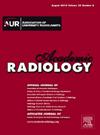Effect of Artificial Intelligence as a Second Reader on the Lung Nodule Detection and Localization Accuracy of Radiologists and Non-radiology Physicians in Chest Radiographs: A Multicenter Reader Study
IF 3.9
2区 医学
Q1 RADIOLOGY, NUCLEAR MEDICINE & MEDICAL IMAGING
引用次数: 0
Abstract
Rationale and Objectives
Missed nodules in chest radiographs (CXRs) are common occurrences. We assessed the effect of artificial intelligence (AI) as a second reader on the accuracy of radiologists and non-radiology physicians in lung nodule detection and localization in CXRs.
Materials and Methods
This retrospective study using the multi-reader multi-case design included 300 CXRs acquired from 40 hospitals across the US. All CXRs had a paired follow-up image (chest CT or CXR) to augment the ground truth establishment for the presence and location of nodules on CXRs by five independent thoracic radiologists. 15 readers (nine radiologists and six non-radiology physicians) read each CXR twice in a second-reader paradigm, once without AI and then immediately with AI assistance. The primary analysis assessed the difference in area-under-the-alternative-free-response-receiver-operating-characteristic-curve (AFROC) of readers with and without AI. Case-level area-under-the-receiver-operating-characteristic-curve (AUROC), sensitivity, and specificity were assessed in secondary analyses.
Results
A total of 300 CXRs (147 with nodules, 153 without nodules) from 300 patients (mean age, 64 years ± 15 [standard deviation]; 174 women) were included. The mean AFROC of readers was 0.73 without AI and 0.81 with AI (95% CI of difference, 0.05–0.10). Case-level AUROC was 0.77 without AI and 0.84 with AI (95% CI of difference, 0.04–0.09). Case-level sensitivity was 72.8% and 83.5% (95% CI of difference, 6.8–14.6) and specificity was 71.1% and 72.0% (95% CI of difference, −0.8–2.6) without and with AI, respectively.
Conclusion
Using AI, readers detected and localized more nodules without any significant difference in false positive interpretations.
人工智能作为第二阅片人对放射科医生和非放射科医生胸部 X 光片肺结节检测和定位准确性的影响:一项多中心阅片研究。
理由和目标:胸片(CXR)中遗漏结节是常见现象。我们评估了人工智能(AI)作为第二阅片人对放射科医生和非放射科医生在 CXR 中肺部结节检测和定位准确性的影响:这项采用多阅片人多病例设计的回顾性研究包括从全美 40 家医院获得的 300 张 CXR。所有的 CXR 都有一个配对的随访图像(胸部 CT 或 CXR),以增强由五位独立的胸部放射科医生对 CXR 上结节的存在和位置建立的地面实况。15 名读片员(9 名放射科医生和 6 名非放射科医生)在第二读片员模式下对每张 CXR 进行两次读片,一次不使用人工智能,然后立即使用人工智能辅助读片。主要分析评估了使用人工智能和不使用人工智能的读者在替代性自由响应接收器操作特征曲线(AFROC)下的区域差异。在二次分析中评估了病例水平的接收器操作特征曲线下面积(AUROC)、灵敏度和特异性:共纳入了 300 名患者(平均年龄为 64 岁 ± 15 [标准差];174 名女性)的 300 张 CXR(147 张有结节,153 张无结节)。无 AI 和有 AI 患者的平均 AFROC 分别为 0.73 和 0.81(差异的 95% CI 为 0.05-0.10)。病例水平的 AUROC 在无人工智能的情况下为 0.77,在有人工智能的情况下为 0.84(95% CI 差异为 0.04-0.09)。无人工智能和有人工智能时的病例水平灵敏度分别为 72.8%和 83.5%(95% CI 差异,6.8-14.6),特异性分别为 71.1%和 72.0%(95% CI 差异,-0.8-2.6):结论:使用人工智能,读者能发现并定位更多的结节,而假阳性判读没有明显差异。
本文章由计算机程序翻译,如有差异,请以英文原文为准。
求助全文
约1分钟内获得全文
求助全文
来源期刊

Academic Radiology
医学-核医学
CiteScore
7.60
自引率
10.40%
发文量
432
审稿时长
18 days
期刊介绍:
Academic Radiology publishes original reports of clinical and laboratory investigations in diagnostic imaging, the diagnostic use of radioactive isotopes, computed tomography, positron emission tomography, magnetic resonance imaging, ultrasound, digital subtraction angiography, image-guided interventions and related techniques. It also includes brief technical reports describing original observations, techniques, and instrumental developments; state-of-the-art reports on clinical issues, new technology and other topics of current medical importance; meta-analyses; scientific studies and opinions on radiologic education; and letters to the Editor.
 求助内容:
求助内容: 应助结果提醒方式:
应助结果提醒方式:


